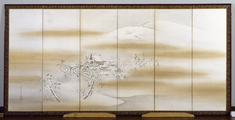Kamigamo Shrine in Summer
(Japan and Korea )
The Kamigamo Shrine is the oldest Shinto shrine in the former Japanese capital of Kyoto. It is dedicated to the deity Kamo-wake-ikazuchi, who appeared miraculously to a daughter of the ruling clan while she was performing a purification ritual in the Kamo River. The deity was initially enshrined at the top of Mount Ko, seen in the distance, but was transferred to this 7th-century building during the Heian period.
The mate to this screen, also in the Walters' collection (35.148), depicts the Byodo-in, a famous Buddhist temple in the nearby town of Uji.
Thiis screen shows a Shinto shrine north of Kyoto and is a one of a pair with "Byodo-in Temple in Winter" (35.148). Working in the style of the 18th-century master Okyo, Mori Kansai wanted the two screens to contrast not only in terms of religion (Buddhist, Shinto), space (south, north), and season (winter, summer) but in the way they are painted--with a sharp contrast of light and dark in "Winter," a subtle gradation in "Summer."
Inscription
Provenance
Provenance (from the French provenir, 'to come from/forth') is the chronology of the ownership, custody, or location of a historical object. Learn more about provenance at the Walters.
[Dealer] Osaka; Toyobi Far Eastern Art [Dr. Frederick Baekeland and Joan D. Baekeland], 1987-1988 [mode of acquisition unknown]; Walters Art Museum, 1989, by purchase.
Geographies
Japan, Kyoto (Place of Origin)
Measurements
H: 18 1/2 x W: 53 3/4 in. (47 x 136.5 cm)
Credit Line
Museum purchase with funds provided by the W. Alton Jones Foundation Acquisition Fund, 1989
Location in Museum
Not on view
Accession Number
In libraries, galleries, museums, and archives, an accession number is a unique identifier assigned to each object in the collection.
In libraries, galleries, museums, and archives, an accession number is a unique identifier assigned to each object in the collection.
35.147



